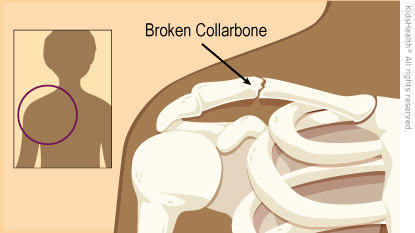Broken Collarbone (Clavicle Fracture)
What Is a Broken Collarbone?
The collarbone (also called the clavicle) is the bone that connects the breastbone to the shoulder. A broken collarbone, also called a clavicle fracture, is when this bone breaks.
How Do Broken Collarbones Happen?
Kids can get a collarbone fracture by falling hard on a shoulder or an outstretched arm, or if their shoulder hits against something or someone (for example, while playing contact sports).

What Are the Signs & Symptoms of a Broken Collarbone?
Someone who breaks a collarbone might have:
- pain over the collarbone
- trouble moving or lifting the arm or shoulder on that side
- swelling, tenderness, and bruising along the collarbone
- skin sticking up or "tenting" above the break
How Is a Broken Collarbone Diagnosed?
To diagnose a collarbone fracture, health care providers ask about how the injury happened, do an exam, and order X-rays.
How Is a Broken Collarbone Treated?
Most broken collarbones heal with a sling and some rest. Sometimes kids might use a shoulder immobilizer instead of a sling. A shoulder immobilizer is like a sling, but also has a strap that goes around the waist. Ice and pain medicine help with pain and swelling. As your child starts feeling better, your health care provider may recommend some exercises or physical therapy to help improve strength.
Call your health care provider if your child has pain or swelling that gets worse.
Will the Collarbone Heal Straight?
Even if the broken bones aren't perfectly lined up, the body usually can make them straight again. That's because the collarbone has a thick periosteum (outer liner on the bone). The collarbone periosteum doesn't usually break, so it acts like a sleeve to hold the bone together while it heals. Rarely, the doctor might recommend surgery if the broken bones are very out of line.
Sometimes, there's a bump where the bone broke. In kids who are still growing, the bump tends to get smaller and go away within a year. Sometimes the bump doesn't fully go away. But it doesn't hurt or cause other problems with the arm or shoulder.
When Can My Child Go Back to Sports?
Your health care provider will see your child again and let you know when it's OK to go back to sports. This is usually when:
- There's no pain when the health care provider presses on the collarbone.
- Shoulder strength is normal.
- Your child can move and use the arm and shoulder without pain.
In general, kids can go back to noncontact sports (such as running or swimming) in about 6 weeks and contact sports (such as football, lacrosse, and hockey) in 8–12 weeks.
What Else Should I Know?
Most broken collarbones heal quickly and completely. Within a few months, kids usually can do everything they did before the injury.
